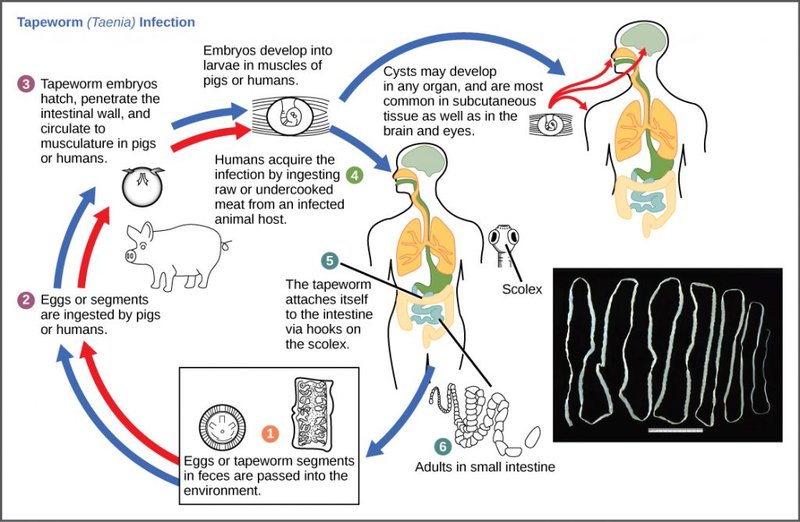
Tapeworms, which are flat, segmented worms found in the intestines of many animals, often go unnoticed and unappreciated. But like many organisms, they contribute to their ecosystems in ways that might not be immediately obvious. Understanding their benefits and drawbacks can help us appreciate the balance of nature. Just like how rainwater nourishes crops but can also lead to flooding, tapeworms have their ups and downs in the ecological arena.
Tapeworms and Their Role in Food Chains
Tapeworms have a unique position in the food chain, often serving as both a predator and a prey. They primarily infect the intestines of larger animals, such as mammals and birds, but their life cycle also involves a variety of intermediate hosts. This means they can impact multiple species across different ecological levels.
For example, when a tapeworm infects a host, it can affect the host’s nutrient absorption. This can slow down the growth of certain populations, allowing other species to thrive. It’s like a see-saw effect: tapeworms can help balance the scales in nature. If a certain herbivore population grows too large, the presence of tapeworms can help control its numbers, allowing other plant and animal species to flourish.
Additionally, as tapeworms die off or are expelled from their hosts, they decompose and return nutrients to the soil. This process enriches the environment, promoting the growth of plants. These plants then support herbivores, continuing the cycle of life. It’s a beautiful example of interconnectedness in ecosystems.
Ecological Benefits of Tapeworm Populations
There are several benefits associated with having tapeworm populations in an ecosystem. Here’s a closer look at a few major points:
1. Nutrient Cycling: Tapeworms play a role in nutrient cycling. When they die or are expelled, their bodies break down and add nutrients back into the soil. This process is crucial because it helps maintain soil health, supporting plant life that feeds herbivores and, ultimately, predators.
2. Host Population Control: By infesting certain animals, tapeworms can help control host populations. This might sound harsh, but in nature, balance is key. Without predators or parasites, some species can multiply too quickly, leading to overgrazing, depletion of resources, and even extinction of other species.
3. Biodiversity Support: The presence of tapeworms can promote biodiversity. They help maintain a variety of species by managing host populations. A balanced ecosystem with several species means a healthier environment overall. This is essential for resilience, allowing ecosystems to withstand changes like climate shifts or disease outbreaks.
Drawbacks of Tapeworm Populations
While tapeworms have their benefits, they can also have some negative impacts on ecosystems. Let’s explore these:
1. Host Impact: Infected hosts can suffer from malnutrition or illness. If too many animals in a population are infested with tapeworms, it could lead to a decline in those species. This can disrupt the food web and lead to a loss of biodiversity.
2. Invasive Species: Some species of tapeworms can become invasive, especially when introduced to new environments. They might outcompete local species and disrupt existing ecosystems. This could result in a decrease in native wildlife populations, creating an imbalance that can take years to correct.
3. Public Health Risks: In some cases, tapeworms can even pose risks to human health. Certain types can be transmitted through contaminated food or water, leading to infections in humans. This adds another layer of complexity to the ecological picture, showcasing how interconnected our ecosystems are.
Tapeworms in Symbiosis
Interestingly, tapeworms can exist in symbiotic relationships with their hosts. In these cases, instead of purely being parasites, they can contribute to the health of their host. Here’s how:
1. Digestion Aid: Some tapeworms might actually help their hosts digest food more efficiently. By breaking down certain nutrients, they enable their hosts to better absorb these essentials. It’s like having an extra helper in the kitchen!
2. Immune System Regulation: Studies suggest that some parasites, including tapeworms, may play a role in training the immune system. This relationship can help an animal’s body become better equipped to fight off other diseases. It’s as if the tapeworm is playing a role in a sort of “training camp” for the immune system.
3. Evolution of Species: The presence of tapeworms can drive evolution in their hosts. Hosts may develop more robust immune systems or even behavioral changes to cope with the infection. This process can diversify species and lead to new adaptations.
Tapeworm populations are a clear example of nature’s balance. They may seem undesirable at first glance, but they bring both benefits and challenges to ecosystems. While they contribute to nutrient cycling and biodiversity, their potential to harm host populations and disrupt habitats cannot be ignored.
Understanding the ecological role of tapeworms helps us appreciate the complexity of our natural world. Just as every piece of a puzzle is important, so too are all the inhabitants of an ecosystem, no matter how small or slimy they may be. So, the next time you think about tapeworms, remember that they’re part of a much larger story—a story that’s as fascinating as it is intricate.

